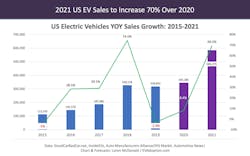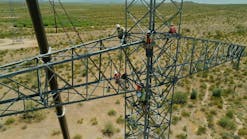Role of State Policy and Regulation in Shaping Adoption, Proliferation of Electrification
At the recent EV Charging Infrastructure Summit on Jan. 26, 2021, panelists discussed key considerations for decision makers at the local, state, and federal level to encourage adoption and deployment of electric vehicles (EVs) and EV infrastructure. The data is clear: EV adoption increases when promotion and regional cooperation, supported by policy tools such as intergovernmental MOUs, renewable energy credits, and rebates for EV purchases, is present and robust.
To date, states with zero-emission vehicle (ZEV) mandates are more effective in promoting personal EV (PEV) adoption, accounting for nearly 30% of PEV sales. Further, a consumer's total cost of ownership is lower in states with state or regional cooperation via MOUs. The prolonged lifespan of an EV reflects an overall benefit to a consumer in these states. To achieve the forecasted growth of EVs in the United States to 20 million in 2030 (from the 1.5 million currently on the road), the electric power sector will need to invest US$75 to US$125 billion, of which US$30 to US$50 billion will be on EV chargers and customer side infrastructure.
While Illinois is well on its way to transforming the roads, lives, and experiences of its residents through Governor Pritzker's Eight Principles for a Clean & Renewable Illinois Economy, it, along with many other states, must address key challenges to realize our goal of a clean energy future.
Key Challenges to Realize Our Clean Energy Goals
First, customer education is essential to promote the societal and environmental reality that electrification benefits all communities on the socio-economic spectrum. State and utility programs must develop educational materials illustrating why the energy transition matters to all communities, including our most vulnerable and marginalized communities.
While there are still financial barriers to making widespread adoption of EVs a reality for all consumers, electrification of the public sector and fleet vehicles will go a long way to reducing carbon emissions in some of the most disadvantaged and marginalized communities, where air quality is poorest and leads to increased illness and negative health outcomes. In addition, utilities can create educational programs to address the confusion around rate structures and demonstrate how ratepayers at every income level can benefit from dynamic rate structures.
Second, EV program and policy development should not exist in a vacuum. Instead, regulators and legislators alike should avail themselves of the experience and research of innovators and pioneers in the industry or regulatory space. As chair of the EV Working Group for NARUC, I have learned firsthand that regulatory commissions across the country are at varying stages of addressing electrification. Regulators and legislators stand to benefit from education and awareness of existing electrification programs developed by other states, whether these programs are fully developed or in their nascent stage. Leveraging the experience and knowledge of other regulators, utilities, or industry experts through forums like NARUC's EV Working Group, webinars by industry experts, or more directly by conducting their own in-state inquiries, workshops, docketed proceedings, or technical conferences, regulators can develop their EV acumen for this emerging field and inevitable transformation.
One essential and useful primer is NARUC's Center for Partnerships & Innovation's December 2019 whitepaper on EVs, Electric Vehicles: Key trends, Issues, and Considerations for State Regulators, which provides key insights on electrification-related issues confronting regulatory agencies. In addition, utility companies and leading industry experts can offer insights to government decision makers about innovations and programs in other jurisdictions or internal research and development.
Third, providing secure, accurate, and essential data to key stakeholders will be essential to the effective deployment and development of electrification infrastructure and programming. For utilities, learning where and how consumers, fleets, and businesses charge is critical because it allows them to develop long-term plans and necessary infrastructure investments for ensuring grid reliability, resilience, and decarbonization.
At the private sector level, large companies like Amazon, Wal-Mart, and Penske want to be able to understand how and where utilities focus infrastructure upgrades and eco-conscious companies want assurances that energy is sourced from clean generation. For government entities, knowing where utility and private sector investments will be made allows for intra-state and regional planning to ensure equal access to all communities and determine necessary long-term capital expenditures to complement or supplement planned projects.
Fourth, we need to ensure that the electric transformation leaves no workers or communities behind. Transitioning to electrification and a decarbonized future will result in a reduction in jobs in fossil fuel-focused industries and the cities and towns that rely on these industries. We need to leverage the electrification transformation to promote economic recovery through job creation and infrastructure development, especially for affected regions.
Utilities and their related companies should consider how the transition to electrification will affect their workforce and what internal solutions, such as new skills training or continuing education programs, can be developed. Additionally, we need to develop more robust fuel standards and stricter emission mandates to improve public health and reduce ecological damage to benefit our most energy and environmentally burdened communities.
In conclusion, the takeaway from the panel discussion at the EV Charging Summit is clear. Along with the dollars expended and investments needed to transform the transportation sector, state government and regulators face key policy considerations that will determine the shape and pace of our electrified future. Ultimately, how these issues are addressed will determine the cost, effectiveness, and equitableness of these innovations and the grid of the future.



